Can dogs eat peaches?
As summer rolls around, we know one thing is coming…peach season! That’s when juicy, fresh peaches begin to pile up at grocery stores and roadside stands, causing both you and your dog to drool all summer long.
Peaches are delicious and fuzzy, and when ripe, they make one of the best and healthiest snacks to munch on. But is this luscious, fiber-filled fruit safe to share with my dog? The answer is yes, with some caveats.
Before you serve your dog this delectable fruit, read on to learn some things you should consider.
Can dogs have peaches?
Good news – yes, your dog can eat peaches! Plus, they’ll probably love them. A peach’s sweet taste and juicy flesh will have your dog’s tail wagging. Plus, they’re crammed with nutrients and actually pack some solid health benefits for your dog.
As with any fruit though, you’ll want to feed your dog peaches in moderation and introduce the fruit slowly to ensure your dog has no adverse reaction to it.
There are, however, some negative aspects to peaches that you should keep in mind. Read on to learn how to ensure the peach is safe for canine consumption.
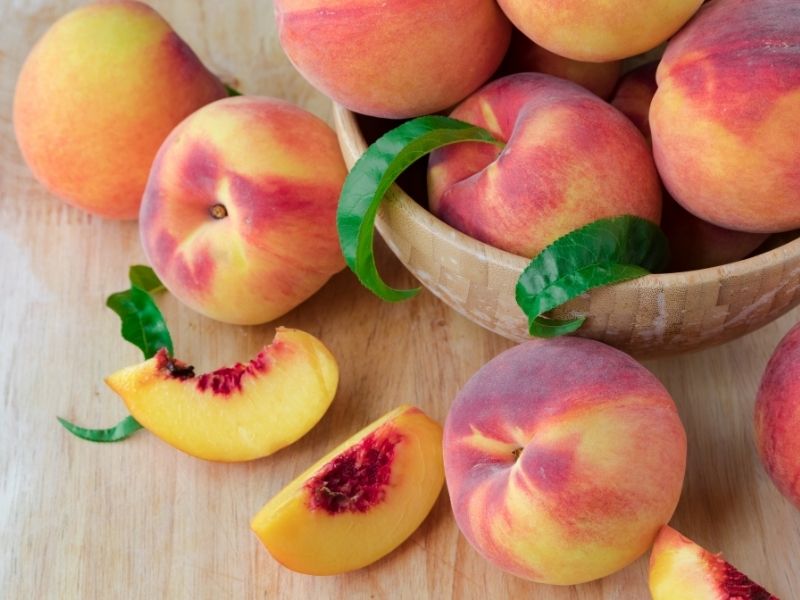
What are the health benefits of peaches?
Delicious, juicy peaches are packed with nutrients. They’re loaded with vitamins and minerals that are good for both you and your dog. That makes them a healthy, not to mention refreshing, option!
Peaches are a great source of the following:
Vitamins: Peaches contain Vitamin A, Vitamin C, and Vitamin E. These vitamins can boost your dog’s immune system, reduce inflammation, improve the quality of the skin and coat, and support proper function of muscles and nerves.
These vitamins can also strengthen bone density. Vitamin A keeps eyes healthy, Vitamin C supports your dog’s immune system, and Vitamin E is critical to certain cell functions and metabolizing fat.
Fiber: Fiber promotes healthy bowel movements, colon health, and relieves your dog of constipation. It also aids in weight management.
Antioxidants: Antioxidants help fight free radicals, which are responsible for cellular and molecular damage. They also protect the body from cancer.
Minerals: Peaches contain minerals like magnesium, potassium, copper and phosphorous. Minerals assist in muscle development, support healthy kidney and heart function, and aid in healthy bone density. They also help the body produce protein, absorb vitamins, and improve heart health.
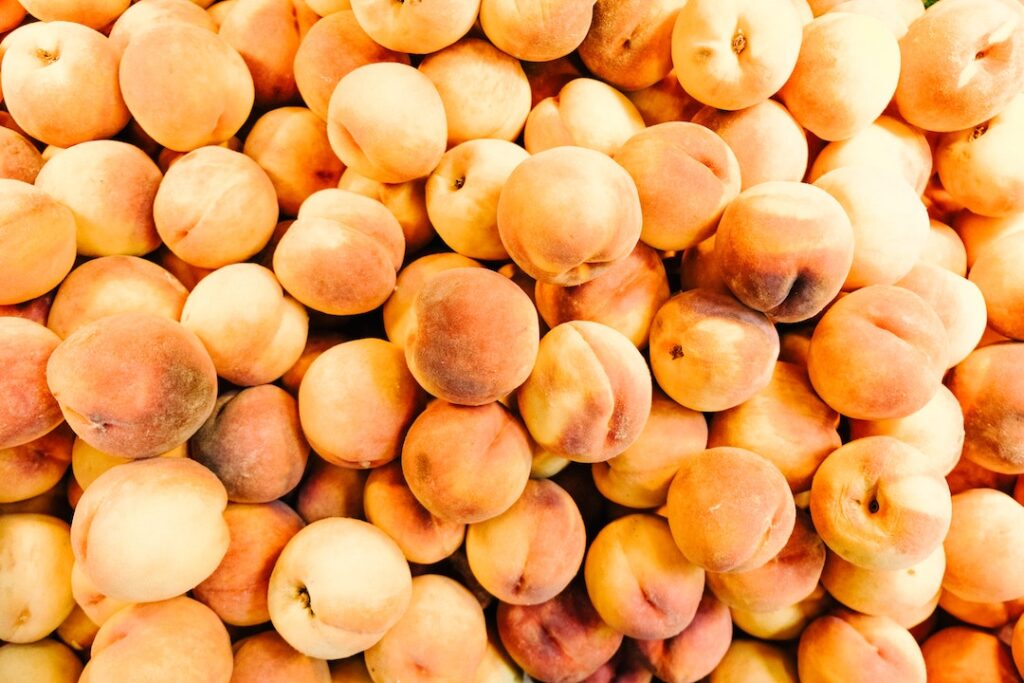
What are the dangers of dogs eating peaches?
Peaches themselves are not bad for dogs. But, there are a few things you should be aware of before feeding them to your dog.
Peach Pits
Perhaps the biggest danger peaches pose to your dog is the pit. Peach pits, also known as stones, are jagged and rough, with a serrated surface. They are an obvious choking hazard, and can get lodged in your dog’s throat if swallowed whole.
If your dog does manage to get one down, the abrasive pit can irritate the small intestine and cause gastrointestinal obstruction. And, just chewing on a peach pit can damage the teeth and jaws.
Besides that, peach pits contain a sugar-cyanide compound called amygdalin. If consumed in large amounts, they can be toxic. Let’s be real, your dog probably won’t be eating a bunch of peach pits, but why take the risk?
If your dog manages to swallow a peach pit, watch for signs of gastrointestinal distress and contact your veterinarian immediately.
Harmful Chemicals
Non-organic peaches are treated with chemical herbicides or pesticides that can easily permeate the thin outer skin. Wash and rinse your peaches thoroughly before feeding them to your dog, and be cautious of unwashed fruit that has fallen from trees.
If the chemicals are used properly, they’re unlikely to cause any toxic effects, but why take the risk?
It’s also worth mentioning that peach leaves and stems, similar to the pit, contain cyanide.
Mold and/or Fermentation
Peaches that have fallen from trees can be risky, as they may have begun to ferment or grow mold. Moldy fruits can cause lots of damage, and fermentation can intoxicate your pet. Skip the fallen fruit.
Eating Too Many
Due to their high sugar and fiber content, eating too many peaches can negatively affect your dog. One fresh peach contains about 8% sugar, which can cause vomiting, diarrhea, or an upset stomach. Stick to small servings and always feed in moderation.
Allergies
It’s unlikely, but still possible that your dog may be allergic to peaches. If your dog shows any signs of an allergic reaction, including sneezing, itching, swelling, coughing, or difficulty breathing, stop feeding them peaches immediately and consult a veterinarian.
And, as with any new food or dog treat, start small. Give your dog a small amount of peach first, and monitor for adverse reactions.
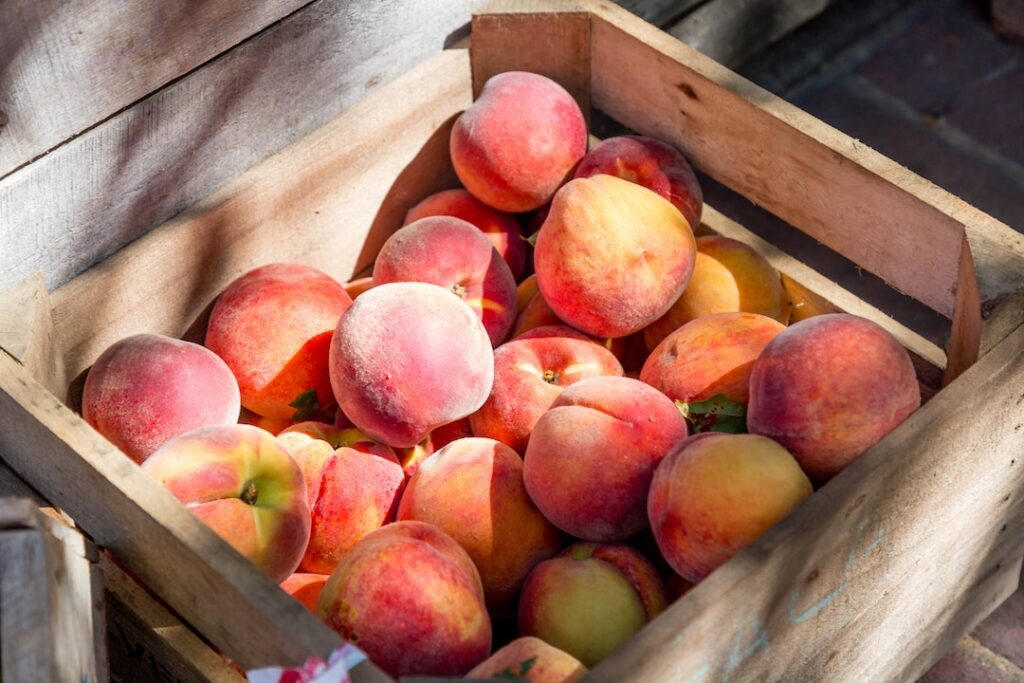
How many peaches can dogs have?
Even though peaches are a healthy snack, they should only be given to your dog in moderation. This goes without saying, but always consult your veterinarian before introducing new snacks.
Peaches should be fed to your dog as an occasional treat, not a meal. Too many peaches can lead to gastrointestinal upset and diarrhea. Don’t forget that peaches are high in fiber and sugar!
I like to follow the popular 90/10 rule when feeding my dog – 90% of your dog’s calories come from healthy, balanced meals, and 10% come from treats. Since fruits like peaches are considered a snack, they should make up no more than 10% of the calories in your dog’s diet.
So, you probably shouldn’t feed your dog a whole peach, but a slice or two should be fine. Fun fact: fresh peaches are about 8% sugar by weight, and one cup of sliced fresh peaches has about 13 grams of sugar and 60 calories. One cup of peach slices also contains about 2.5 grams of dietary fiber.

How to safely serve peaches to dogs:
Preparing peaches for your dog’s consumption is easy! There are only a few things to keep in mind to ensure you avoid any hazards. As always, check with your veterinarian before introducing a new food to your dog, and don’t forget to get their recommendation on serving size.
To safely serve peaches to your dog, do the following:
- Remove the stem and all leaves. Don’t feed these pieces to your dog, compost them instead!
- Wash and rinse the peach. Rinse the peach thoroughly to wash off any bacteria, pesticides, or dirt. This is especially important if your peach is not organic.
- Cut the peach in half and remove the pit. Be sure to compost or trash the pit in a place that’s away from your dog’s reach.
- Cut the peach into bite-sized pieces. Avoid the risk of choking by cutting the peach into small pieces, like slices or small cubes. Remember to size them appropriately, so your dog doesn’t have trouble chewing, and to prevent choking.
- Enjoy! Supervise your dog as they consume the juicy, delicious treat.
It’s easy to feed your dog fresh peaches in slices or pieces, but there are many other ways for your dog to enjoy this summertime treat. Here are a few safe ways to feed your dog peaches:
- Frozen: Freeze the peach slices or pieces in a Tupperware or Ziploc bag. You can also freeze peaches with water or coconut water in an ice cube tray for a longer lasting treat. Frozen peaches are a great treat on a hot summer day!
- Purée: Purée fresh peaches. You can serve up a peach smoothie, or freeze the purée in an ice cube tray to make peach sorbet.
- Dried: Dehydrated peaches make great, chewy treats.
- Mashed: Mash peaches into a jam. Serve alone or as a food topper. Great for dogs with few to no teeth!
- Fruit Salad: Mix peach slices with other dog-safe fruits like bananas and apples for a sweet treat.
- Peach ice cream: Blend frozen peaches or peach purée with plain, unsweetened yogurt. This makes a refreshing, delicious peach dog-friendly ice cream. Be sure the yogurt has no added sugars, sweeteners, or flavors, and that Xylitol isn’t listed in the ingredient list.
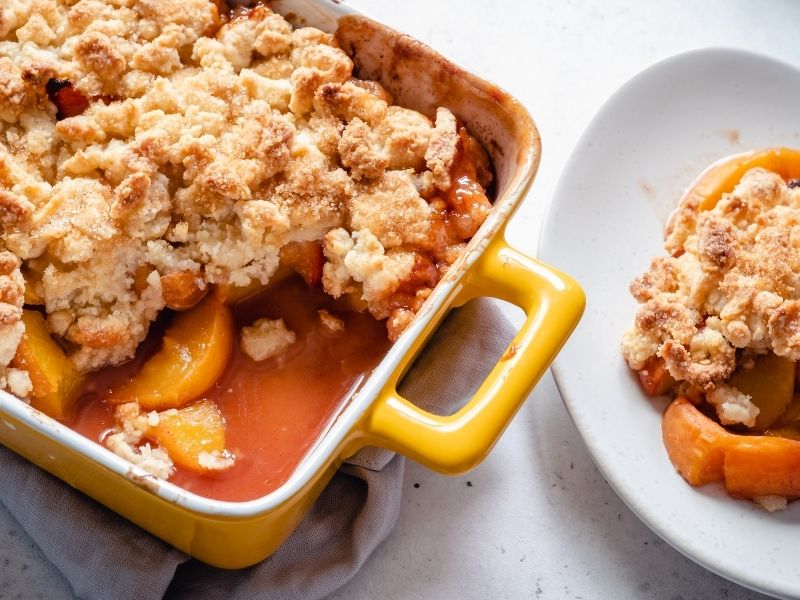
Can dogs eat peach cobbler?
Just hearing these two words together, peach and cobber, makes my mouth water. Everyone loves peach cobbler! And while I’m sure your dog would probably love it too, they shouldn’t get any. Bummer.
Peach cobbler, though delicious, is full of ingredients that are best to avoid in your dog’s diet, like sugar, butter, and flour. These ingredients contain no nutritional value for your dog, and could cause issues like an upset stomach or diarrhea.
It’s best to skip the cobbler, and leave it for the humans.
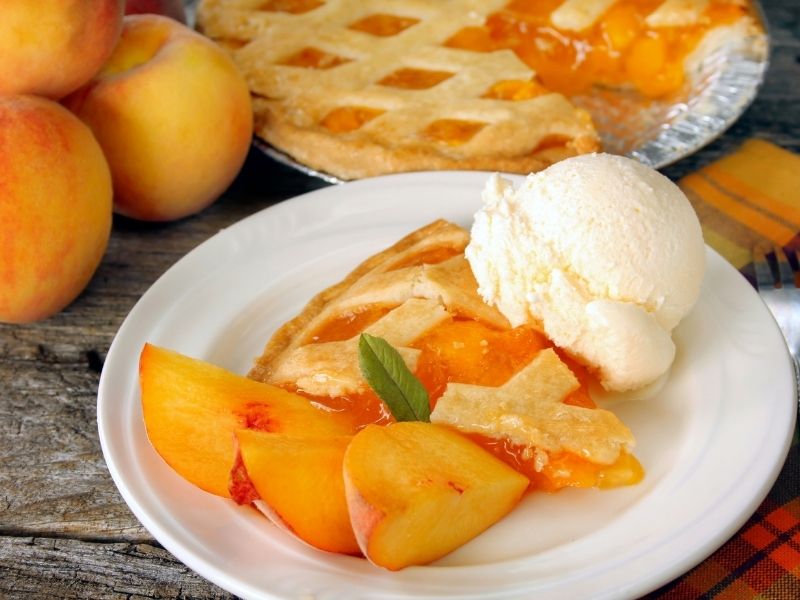
Can dogs eat peach pie?
They probably shouldn’t. Pies are similar to cobblers; the difference being that pies always have a bottom crust, and cobblers don’t.
Peach pies are also made using pretty much the same ingredients as cobblers, namely fruit, butter, flour, and typically lots of sugar, amongst other things.
Like peach cobbler, reserve the pie for human consumption and don’t feed any to your dog.
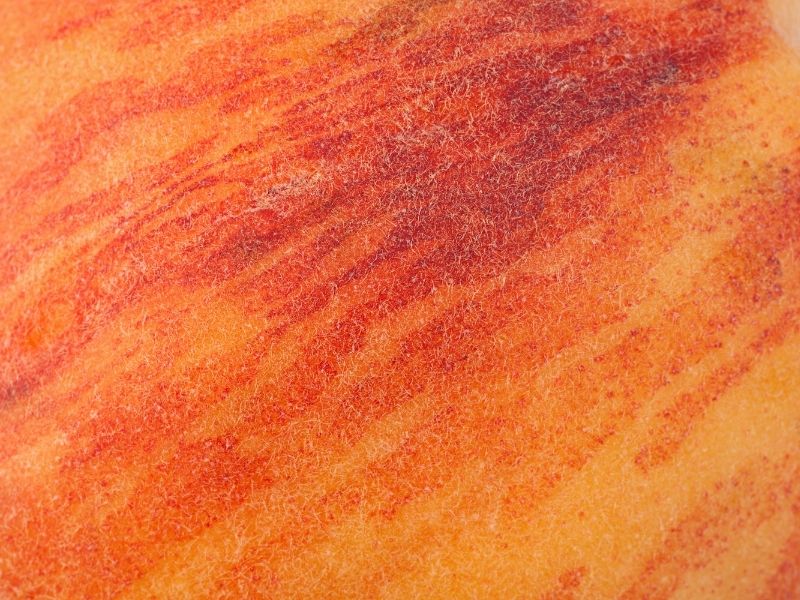
Can dogs eat peach skin?
Yes, dogs can eat peach skin.
Peach skin is perfectly safe in small, bite sized pieces. If you want to feed your dog larger or longer pieces of peach, like a slice, consider removing the skin – it can get stuck in your dog’s throat and turn into a choking and coughing hazard.
Can dogs have peach pits?
No, dogs cannot eat peach pits.
There are certain foods, like dragon fruit, where seeds are ok for dogs to consume. But peaches are a stone fruit, similar to plums, apricots and cherries. Their seed, the peach pit, also known as the peach stone, presents a choking hazard.
If ingested, the pit can cause an intestinal blockage, and even require surgery to be removed. If left untreated, obstructions like this can be fatal.
A peach pit is also incredibly rough and abrasive. The hard center can damage or break your dog’s teeth, causing painful fractures into the nerves. The sharp, serrated texture can also damage the lining of the throat, intestines, and/or stomach.
If you needed yet another reason to avoid the peach pit, then know this: the pit also contains amygdalin, a toxic cyanogenic compound that can cause health problems if ingested in high amounts.
Sure, your dog would have to eat more than one peach pit for the amygdalin to cause serious issues, but it’s better to be safe than sorry. Trash the pit, or compost it, and keep it out of paw’s reach.
Peach fact: amygdalin is also present in peach leaves and the stem.
If your dog does get their paws on a peach pit and actually manages to swallow it, there are a few things to do and look out for:
- Monitor your dog to see if there are any changes in their behavior.
- Contact your vet ASAP if your dog shows any signs of cyanide toxicity, intestinal blockage, or esophagus damage.
- Symptoms include, but are not limited to: appetite loss, abdominal pain, diarrhea, difficulty barking, gagging, severe panting, and more.
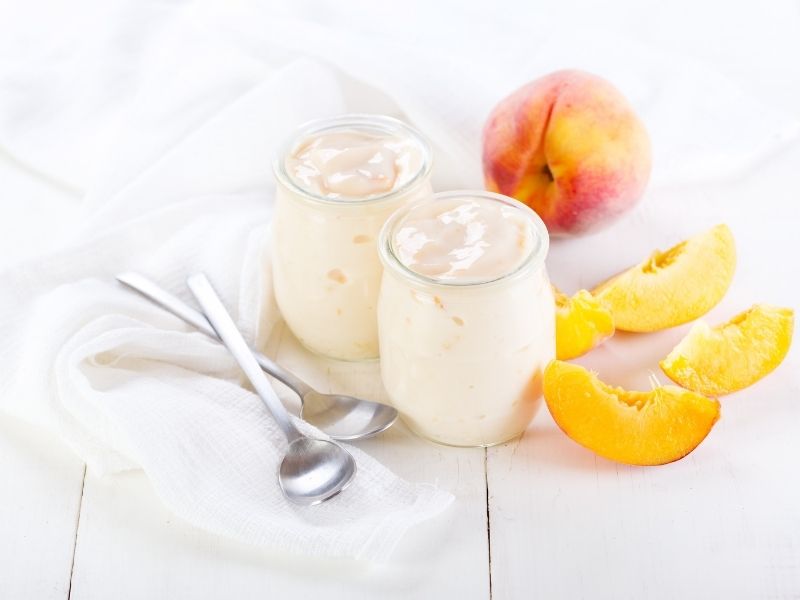
Can dogs eat peach yogurt?
It depends! Store-bought peach yogurt usually contains artificial flavors and preservatives, which can be bad for your canine companion. It might even contain artificial sweeteners like xylitol, which can be toxic for dogs. Those sugary store-bought yogurts are a less nutritious form of eating peaches, with little nutritional value.
If you want to feed your dog peach yogurt, the best option is to prepare it yourself. Combine plain yogurt with organic peaches for a dog-friendly version. Be sure to give your dog a little bit of yogurt first to see how they handle it.
Another thing – feed the homemade yogurt to your dog in moderation. You can have them to lick it, add it to a Kong, or freeze it in ice cube trays.
Can dogs eat peach jam?
Probably not. Processed jams, typically bought in stores, are usually high in sugar which can cause stomach problems. Too much sugar is never good for your dog. What’s more, some jams contain artificial sweeteners like xylitol which are toxic to dogs.
Even jams made at home typically have high sugar content. Remember to steer clear of sugar-heavy, peach-flavored products, no matter how yummy they are.
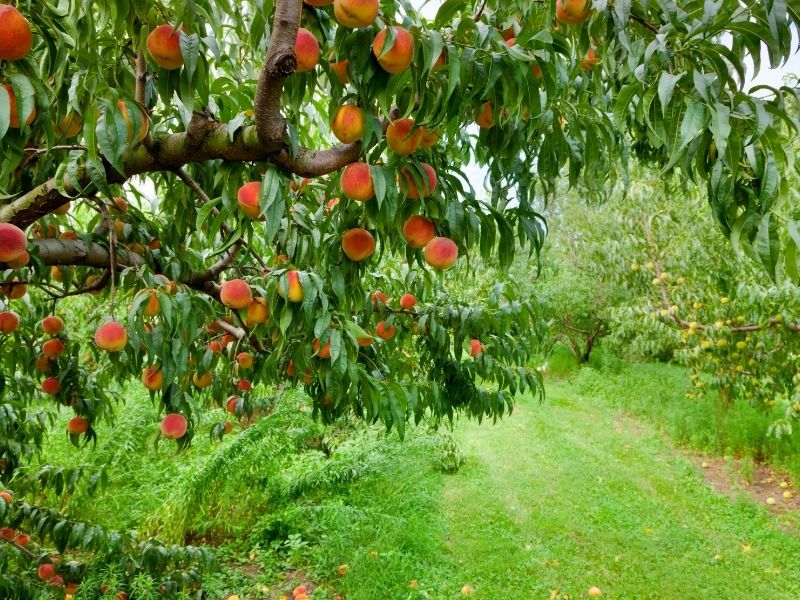
Windfall peaches: the lowdown
Windfall refers to fruit blown down from a tree or bush by the wind. If you’re walking in an orchard or by a peach tree, your dog may encounter some windfall peaches on the ground. Should you let them eat it? No.
If your dog comes across windfall peaches, do your best to avoid them. Here are a few reasons why:
For one, there’s always a chance that the peach tree has been sprayed with pesticides or other chemicals. The chemicals can be harmful to your pet if consumed in large amounts. It’s worth noting, however, that if these chemicals have been used in the correct concentrations, they’re unlikely to be harmful to your dog. That said, it’s best to avoid the risk altogether.
There’s also the risk of fermentation. Fermentation means that ethanol (alcohol) production has started. Peaches that have been lying on the ground for a few days will begin to ferment. Your dog could get drunk, sick, or, if they eat a lot of peaches, they can even get alcohol poisoning. If you suspect that your dog has eaten fermented peaches, contact your veterinarian immediately.
If the peaches have been there for a while, they will start to rot and grow mold. Mold poses a significant risk to dogs, and if eaten, can make them very sick. Mycotoxin toxicity can be fatal. If you suspect your dog has eaten rotten and/or moldy peaches, contact your veterinarian immediately.
Can dogs eat canned peaches?
Preserved or canned peaches are typically high in added sugars and contain preservatives, especially those canned in syrup. Both of these additives can be harmful for your dog.
Some canned peaches may also contain artificial sweeteners such as xylitol, which is poisonous to dogs.
Let’s compare fresh peaches to canned: a medium fresh peach is around 150g and will typically contain about 11g of sugar. Canned peaches usually have 11g of sugar per 100g – that’s significantly more sugar!
Your dog doesn’t need the extra sugar or calories, so keep the tinned peaches for yourself.
Can dogs eat grilled peaches?
Some people like to kick their peaches up a notch and eat them grilled. That’s right, grilled peaches are a favorite summertime treat once the barbeque comes out.
Your dog can enjoy them too, depending on how they’re made. If your grilled peaches get dressed with a drizzle of honey, a bit of sugar, and/or butter, it’s probably best for your dog to skip this round.
But, if they’re just fresh peaches on the grill, then go for it. Just be sure to let them cool before serving them up. Don’t forget to feed peaches in moderation.







